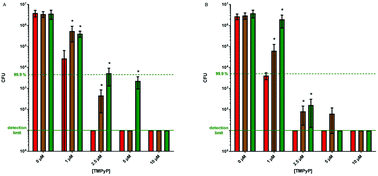当前位置:
X-MOL 学术
›
Photochem. Photobiol. Sci.
›
论文详情
Our official English website, www.x-mol.net, welcomes your
feedback! (Note: you will need to create a separate account there.)
Susceptibility of sodA- and sodB-deficient Escherichia coli mutant towards antimicrobial photodynamic inactivation via the type I-mechanism of action
Photochemical & Photobiological Sciences ( IF 2.7 ) Pub Date : 2018-02-28 00:00:00 , DOI: 10.1039/c7pp00370f Pouriya Faraj Tabrizi 1, 2, 3, 4 , Sara Wennige 1, 2, 3, 4 , Mark Berneburg 1, 2, 3, 4 , Tim Maisch 1, 2, 3, 4
Photochemical & Photobiological Sciences ( IF 2.7 ) Pub Date : 2018-02-28 00:00:00 , DOI: 10.1039/c7pp00370f Pouriya Faraj Tabrizi 1, 2, 3, 4 , Sara Wennige 1, 2, 3, 4 , Mark Berneburg 1, 2, 3, 4 , Tim Maisch 1, 2, 3, 4
Affiliation

|
Photodynamic antimicrobial chemotherapy (PACT) is a multi-target method to inactivate pathogenic microorganisms by exciting a photosensitizer (PS) with visible light of appropriate wavelength in the presence of molecular oxygen (3O2). There are two major pathways by which reactive oxygen species (ROS) are produced. In type I (TI)-reactions, radicals such as superoxide (O2˙−) and hydroxyl radicals (˙OH) are generated by electron transfer. In type II (TII)-reactions, highly reactive singlet oxygen (1O2) is produced by direct energy transfer. This study investigated the efficiency of PACT in Gram-negative Escherichia coli wild type (EC WT) and the mutant Escherichia coli PN134 (EC PN134) which is not able to produce SOD A and SOD B, by means of two different photosensitizers (PS) from different chemical classes with different 1O2 quantum yields: methylene blue (MB) and 5,10,15,20-tetrakis(1-methyl-4-pyridinio)porphyrin tetra(p-toluenesulfonate) (TMPyP). Mutants, which lack antioxidant enzymes, were particularly susceptible towards TI-PACT. In the case of PACT with MB, quenching agents such as superoxide dismutase (SOD) and catalase (CAT) were sufficient for protecting both the wild type and the mutant, whereas they were not in PACT with TMPyP. The genetic levels of sodA and sodB were examined after photodynamic treatment regarding their potential resistance. This study showed that – under the photodynamic conditions presented in this study – expression of sodA and sodB was not directly influenced by PACT-generated oxidative stress, although SOD enzymes are part of the major defense machinery against oxidative stress and were thus expected to be upregulated. Overall the susceptibility of EC PN134 and EC WT differed towards photodynamic inactivation via TI-mechanism of action. Thus, already existing defense mechanisms against ROS in bacteria might influence the susceptibility against TI-PACT, while this was not the case using TII-photosensitizers.
中文翻译:

sodA和sodB缺陷型大肠杆菌突变体通过I型作用机制 对抗菌素光动力学失活的敏感性
光动力抗菌化学疗法(PACT)是一种多目标方法,可通过在分子氧(3 O 2)存在下用适当波长的可见光激发光敏剂(PS)来灭活病原微生物。产生活性氧(ROS)的途径主要有两个。在I型(T我)-reactions,自由基如超氧(O 2 ˙ - )和羟基自由基(OH)是由电子转移产生。在II型(T II)反应中,通过直接能量转移产生高反应性单线态氧(1 O 2)。这项研究调查了PACT在革兰氏阴性大肠杆菌中的效率野生型(EC WT)和突变型大肠杆菌PN134(EC PN134),该突变体不能通过两种不同的光敏剂(PS)来产生SOD A和SOD B,这两种化学剂来自不同的化学类别,具有不同的1 O 2量子产率:亚甲基蓝色(MB)和5,10,15,20-四(1-甲基-4-吡啶基)卟啉四(对甲苯磺酸盐)(TMPyP)。缺乏抗氧化酶的突变体特别容易感染T I-协议。在使用MB的PACT情况下,淬灭剂(如超氧化物歧化酶(SOD)和过氧化氢酶(CAT))足以保护野生型和突变体,而在使用TMPyP的PACT中则不能。光动力学处理后检查其sodA和sodB的遗传水平,以了解其潜在耐药性。这项研究表明,在本研究提出的光动力学条件下,尽管POD酶是抵抗氧化应激的主要防御机制的一部分,但sodA和sodB的表达不受PACT产生的氧化应激的直接影响。 。总体而言,EC PN134和EC WT的敏感性在通过T I导致光动力学失活方面有所不同动作机制。因此,细菌中已经存在的针对ROS的防御机制可能会影响对T I -PACT的敏感性,而使用T II-光敏剂却并非如此。
更新日期:2018-02-28
中文翻译:

sodA和sodB缺陷型大肠杆菌突变体通过I型作用机制 对抗菌素光动力学失活的敏感性
光动力抗菌化学疗法(PACT)是一种多目标方法,可通过在分子氧(3 O 2)存在下用适当波长的可见光激发光敏剂(PS)来灭活病原微生物。产生活性氧(ROS)的途径主要有两个。在I型(T我)-reactions,自由基如超氧(O 2 ˙ - )和羟基自由基(OH)是由电子转移产生。在II型(T II)反应中,通过直接能量转移产生高反应性单线态氧(1 O 2)。这项研究调查了PACT在革兰氏阴性大肠杆菌中的效率野生型(EC WT)和突变型大肠杆菌PN134(EC PN134),该突变体不能通过两种不同的光敏剂(PS)来产生SOD A和SOD B,这两种化学剂来自不同的化学类别,具有不同的1 O 2量子产率:亚甲基蓝色(MB)和5,10,15,20-四(1-甲基-4-吡啶基)卟啉四(对甲苯磺酸盐)(TMPyP)。缺乏抗氧化酶的突变体特别容易感染T I-协议。在使用MB的PACT情况下,淬灭剂(如超氧化物歧化酶(SOD)和过氧化氢酶(CAT))足以保护野生型和突变体,而在使用TMPyP的PACT中则不能。光动力学处理后检查其sodA和sodB的遗传水平,以了解其潜在耐药性。这项研究表明,在本研究提出的光动力学条件下,尽管POD酶是抵抗氧化应激的主要防御机制的一部分,但sodA和sodB的表达不受PACT产生的氧化应激的直接影响。 。总体而言,EC PN134和EC WT的敏感性在通过T I导致光动力学失活方面有所不同动作机制。因此,细菌中已经存在的针对ROS的防御机制可能会影响对T I -PACT的敏感性,而使用T II-光敏剂却并非如此。











































 京公网安备 11010802027423号
京公网安备 11010802027423号